Spotlight on Loren Elliott
Jan 19, 2017
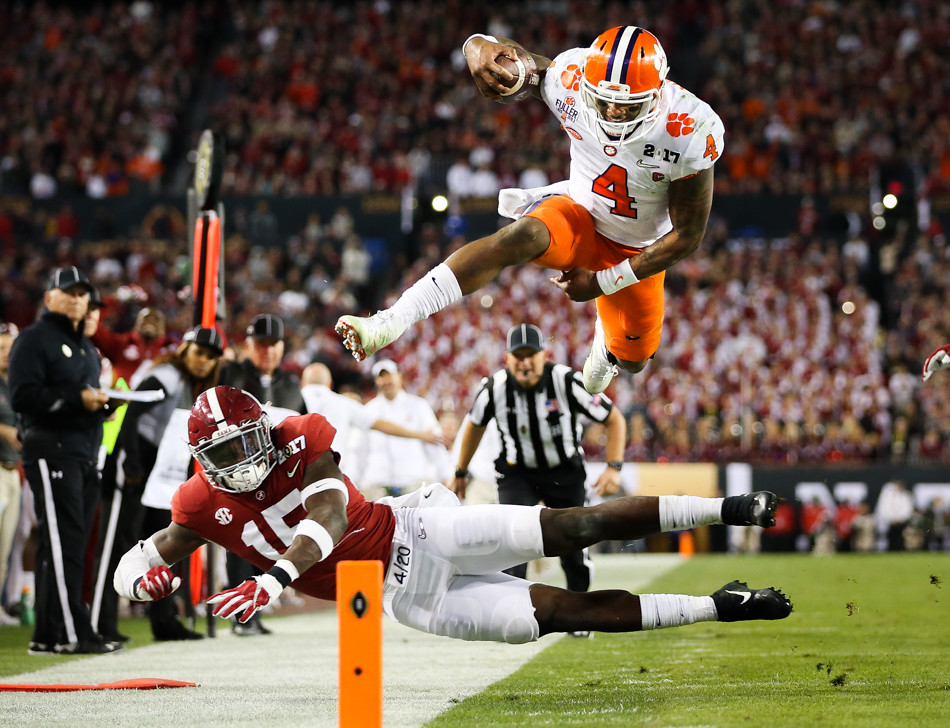
TID:
What a great picture! I’d love to learn more about it, can you tell us some of the backstory?
LOREN:
Sure thing, Ross. I’ve gone through posts on this site countless times for inspiration, so it’s really humbling to get the chance to contribute.
The College Football Playoff National Championship, much like the Super Bowl, is hosted in a different neutral city each year. This year it came to Tampa’s Raymond James Stadium, where I cover the Buccaneers during the NFL season. Given the significance of a National Championship in our town, the Tampa Bay Times employed a team of six photographers, two card runners, two onsite editors, and folks back at the office on the photo desk.
My season covering the Buccaneers had just ended, so this game was a last chance to make some football pictures before changing gears and focusing on projects and news assignments.
TID:
To begin with, what type of preparation went into covering such a large and important game?
LOREN:
I’d be remiss not to give a shout-out to my colleague Will Vragovic, also a staff photojournalist at the Times, who coordinated all of the logistics leading up to game day. Will handled the credentialing process, securing shooting positions, equipment loans from Canon Professional Services and so on. The other five of us photographers had it easy.
I was equipped with three 1DX bodies, a 200-400, 70-200, 24-70 and 16-35. I connected early in the day with the College Football Playoff’s still photo contact onsite, so he’d be familiar with me. He escorted myself and a handful of other photographers onto the field for shooting the national anthem, and ran me through the logistics of getting inside the barrier for the trophy ceremony. Having the right gear and connecting with the guy in charge of photographer access early were the two most important parts of game day preparation for me.
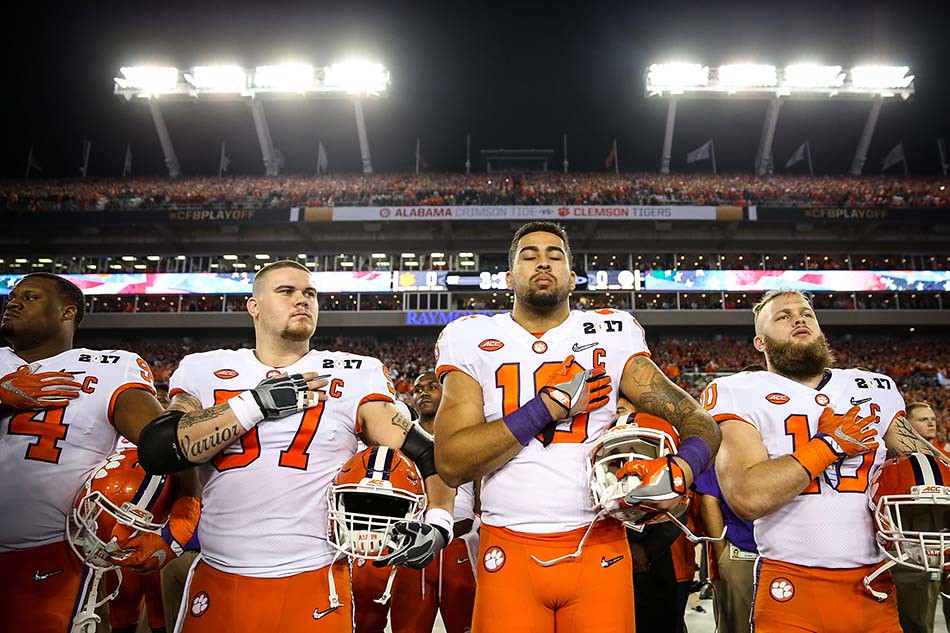
TID:
Can you talk about some of the logistics of the beginning of the shoot. How did you work the stadium, etc when you first arrived? Many people don’t get the chance to cover such an event and don’t know what it’s like?
LOREN:
For a typical NFL game at Raymond James Stadium, where I cover the Buccaneers, I would arrive three hours early with one fellow photographer and no card runners or onsite editors. But because of the magnitude of the college National Championship, coupled with a nightmarishly late kickoff for print deadlines, we were a team of 10 total at the stadium, between photographers, card runners and editors. Shooters arrived at 11:00am for an 8:00pm kickoff. That might sound crazy, but it gave us time to ensure we had our own table secured in the workroom, trouble-shoot any possible issues with Ethernet connections and Wi-Fi, make feature photos and videos of the tailgating scene outside the stadium, setup remote cameras at elevated positions, and the list goes on. Preparation is key to covering such a big game.
Upon arrival we got our area in the workroom setup, and then everyone went about his or her different assigned tasks. For me, that meant heading outside with a reporter to make a video on the tailgating scene. Once that was completed, I headed to the upper deck of the stadium to help with remotes and make some feature pictures. Later we had a team meeting, where we went over plans regarding who would be shooting where, when and where photographers would hand off cards to runners, and that sort of thing. We then had a meal together, attended the mandatory photo meeting put on by the event organizers, and then I headed out to cover team arrivals.
The rest of the night turned into blur of shooting, from warm-ups to the game to the trophy ceremony and celebrations. We had one photographer in each end zone corner, one in an elevated position and another roaming the stadium shooting features. I’m accustomed to working a whole side of the field, so it was a change of pace to camp out in one corner all game. It gave me the chance to focus on sideline reactions more than I usually would. From start to finish, it ended up being a 17-hour day.
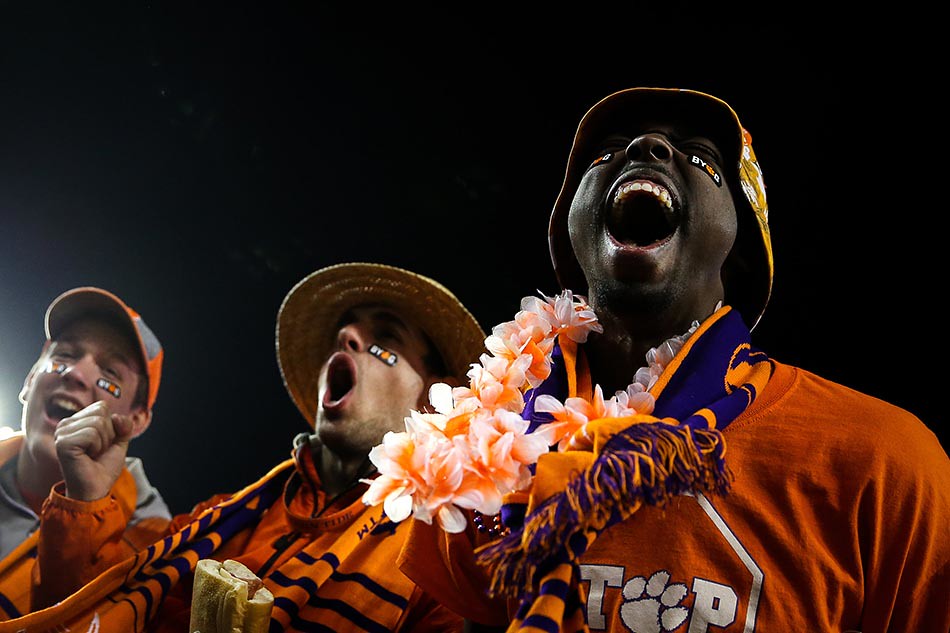
TID:
What did you learn about yourself during this shoot? I’m also intrigued by what photographers learn about themselves during games like this?
LOREN:
I have a tendency to become impatient when I go an extended period of time without making a strong picture, especially when I had opportunities to do so and didn’t capitalize. The first half of this game was relatively slow, without a lot of action in my corner, and I had my 70-200 up to my eye the one time a coach went ballistic on the sidelines and I couldn’t get to my 400mm fast enough. I’m the worst when it comes to obsessing over missed opportunities.
I tried hard to remind myself that the first half wasn’t that consequential anyways, and if I was going to capitalize on opportunities late in the game when it would really matter, I would need to clear my mind. I made a concerted effort to let go of the shots I had missed earlier in the game, so I could fully focus on the shots I hadn’t yet taken. I think that paid off in making me sharper when the fourth quarter turned crazy.
So in summary, this game reaffirmed for me that I'm at my best when I can quiet my mind and let go of the shots I blew, because I need to be completely focused on the picture I’m about to make. Peak action in sports is so fleeting. Without total concentration, it becomes very easy to just barely miss it. If my mind is still hung up on a play or reaction that happened five minutes ago, I’m unlikely to nail what might be the play of the game.
TID:
What surprised you most about covering the game?
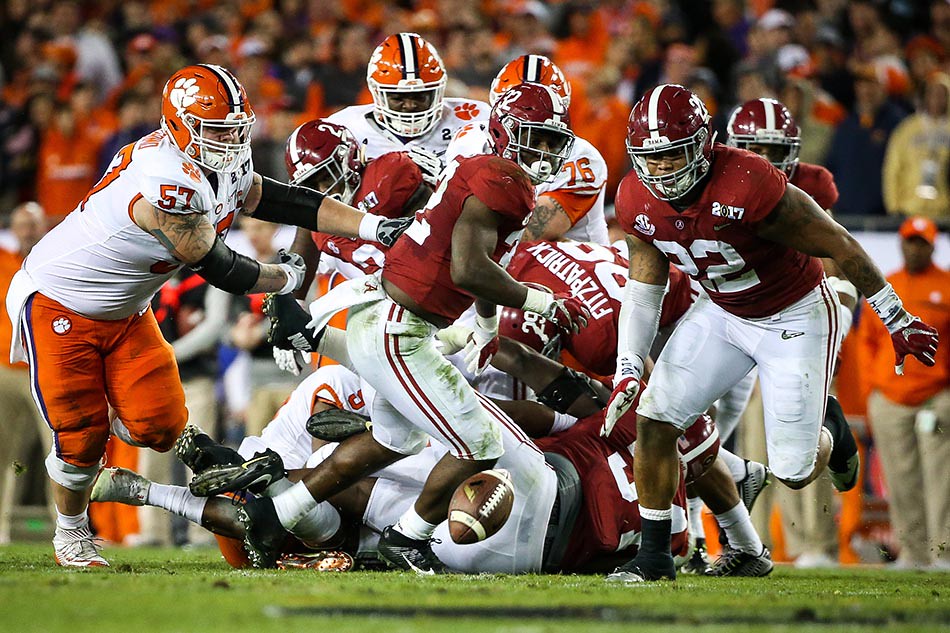
LOREN:
I think Clemson coming from way behind to pull off a fourth quarter win was the night’s biggest surprise, for me and everyone else in the stadium! I covered Alabama crushing Florida in the 2015 SEC Championship and Missouri in the 2014 SEC Championship, so I’ve seen how dominating of a team they are up close. After Clemson fell behind 14-0 and stayed behind into the fourth quarter, I figured it would turn into another Alabama win. Still cool to shoot a National Championship, but nothing very exciting about Alabama winning their trillionth game in a row. For Clemson to come from behind and pull off an upset so late in the game, it was a real thrill. The energy toward the end was just incredible. Nobody could believe what was happening. Alabama was stunned when the clock ran out. Documenting that level of upset was the coolest thing I’ve experienced in the sports world.
TID:
Now, onto the moment. Can you tell us what was going on in the lead picture and how you worked to execute the picture?
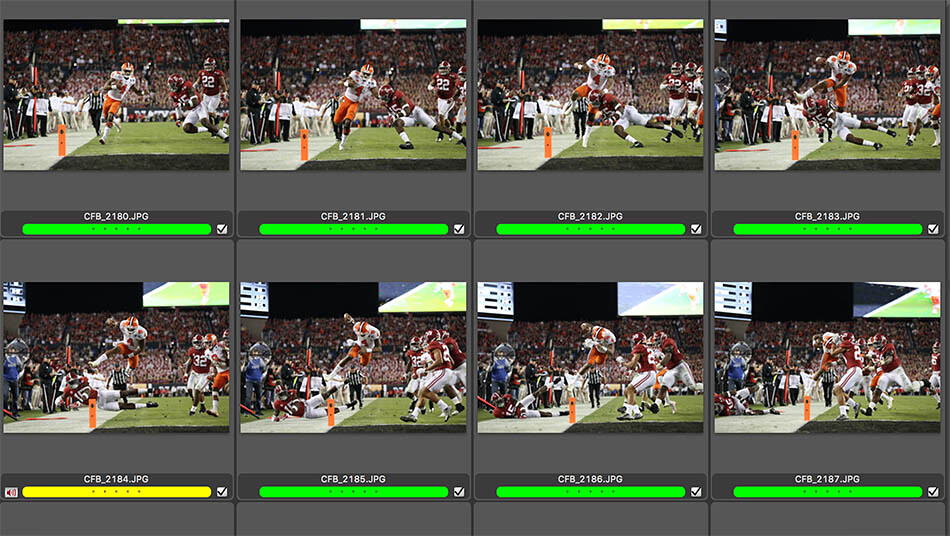
LOREN:
My assigned mat was behind the end zone and about ten yards away from the rear corner pylon (toward the middle of the field). I shot the first half of the game from there, not wanting to rock the boat. I much prefer shooting football from right behind the rear pylon, because it lines you up with the sideline. That gives a much cleaner background and better angle for plays that come to the front corner pylon. Instead of a background of photographers and TV people, there’s a mostly obstruction-free background all the way down the sideline for 110 yards to the far end zone (which is blurred past oblivion at F2.8).
During the first half, shooting from a less than ideal position, I observed that my favorite spot in the corner sat vacant when action was on the opposite side of the field, but it became a cluster of roaming photographers without assigned spots when the action came to my end zone. For the second half, I decided to move to my preferred spot behind the back pylon. I did so when action was on the opposite side of the field, so I’d have that shooting position when probably thirty roaming shooters would return to that corner. (This area didn’t have assigned spots, the only rule was don’t obstruct the TV crew, and other shooters knew it was fair game to set up at my assigned spot 10 yards away if I wasn’t there.)
I was shooting with three bodies and a 24-70, 70-200 and 200-400. When Clemson got into the red zone I put down the 200-400 and was at the ready with just the two shorter lenses. As Watson rolled to his right, I tracked him with the 70-200 and hammered the shutter as I saw him go into the air. The picture was made at 135mm and F2.8.
TID:
I love problem solving and think it’s such an important part of being a great photographer? What problems did you face and how did you work through them?
LOREN:
I honestly didn’t have to do much in the way of problem solving for this game. Will Vragovic made life pretty easy for the other five shooters, arranging loaner gear from CPS, credentials and shooting positions.
The only thing I did in the way of problem solving, as detailed above, was recognizing that the assigned shooting position we were given was not in an ideal location and working around that. I count myself lucky that such a big game went so smoothly, and the credit there goes to the support team of onsite editors, card runners and Will’s pregame coordination. We had a really solid team out there.
TID:
I’ve never been particularly strong at shooting sports action. In conclusion, do you have any advice for photographers who want to improve shooting sports?
LOREN:
I think the biggest key to nailing sports action is anticipation. It’s hard to anticipate without knowing the game and players in it. I’m no football expert, but I’ve shot enough college and NFL action to read body language as a play is unfolding. I also knew that Deshaun Watson is an exceptionally athletic quarterback, and if any QB might favor keeping the ball on a scramble and going for the end zone himself, it would be him. The guy can run. With that knowledge, I was confident in keeping the 70-200 to my eye and staying on Watson, knowing I’d be in trouble if he threw a dart to a receiver in my back corner of the end zone (where even 70mm would be way too long). If it were Tom Brady and the Patriots out there, you can be sure I’d have put the 24-70 to my eye and prepared for a pass to the back of the end zone as soon as I saw his scramble approach the line of scrimmage.
So my advice is get to know the sport you’re covering, and do your homework on the players involved. Be familiar with the style of offense each team runs and the tendencies the star players have, because it’ll pay off when you have a split second to decide where a play is going and which lens is going to be highest percentage.
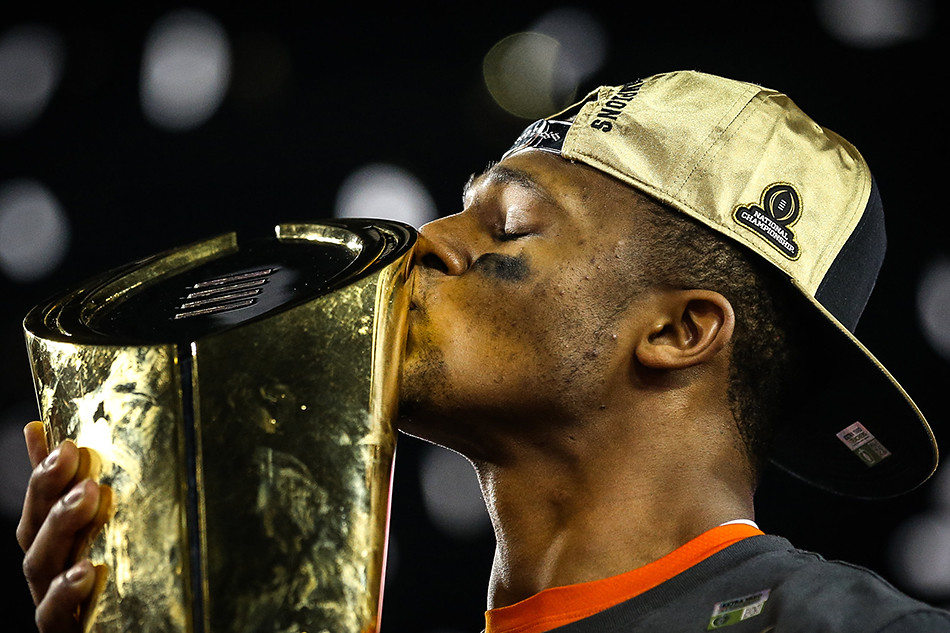
:::BIO:::
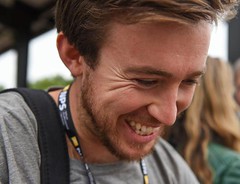
Elliott is a staff photojournalist at The Tampa Bay Times by way of California, Missouri and Washington. His job has taken him everywhere from the Tampa Bay Buccaneers bench to presidential campaign rallies, helicopter rides over the Gulf of Mexico, parenting classes at a county jail and the mass shooting at Pulse nightclub.
Before moving to the Sunshine State in 2015, he covered wildfires, the legalization of same-sex marriage and the effects of climate change on Northern California's shellfish industry at the San Francisco Chronicle. Before that, he was a multimedia editor and staff photographer at the Columbia Missourian.
Elliott attended graduate school at the University of Missouri School of Journalism and received a bachelor's degree in environmental studies from Seattle University. Life in the Pacific Northwest fueled his love for ferry rides and pitching a tent in the rainforest.
His work has been featured in publications such as The New York Times, The Washington Post, Sports Illustrated, The Wall Street Journal, National Geographic Proof, The Los Angeles Times, TIME.com, The Boston Globe, The Denver Post, The Chicago Tribune and The Guardian, in addition to being recognized by Pictures of the Year International, College Photographer of the Year, Florida Society of News Editors, and the Missouri Press Association.
You can see more of his work here: www.LorenElliottPhoto.com
Instagram: @LorenElliottPhoto
Twitter: @LelliottPhoto